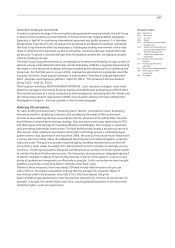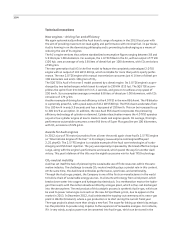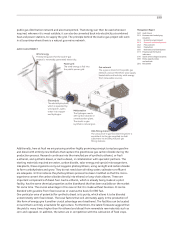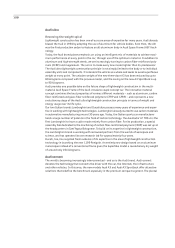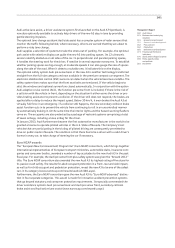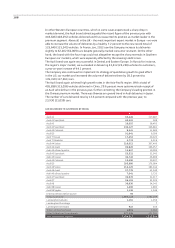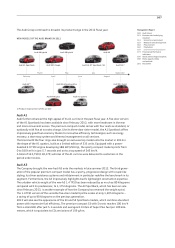Audi 2012 Annual Report Download - page 154
Download and view the complete annual report
Please find page 154 of the 2012 Audi annual report below. You can navigate through the pages in the report by either clicking on the pages listed below, or by using the keyword search tool below to find specific information within the annual report.
157
Management Report
140 Audi Group
151 Business and underlying
situation
151 Economic environment
153 Research and development
162 Procurement
162 Production
165 Deliveries and distribution
173 Financial performance
indicators
176 Social and ecological aspects
190 Risks, opportunities
and outlook
201 Disclaimer
Charging technologies
The overall concept of electric mobility encompasses all aspects, including the charging technology
for the drive battery – a high-voltage power pack.
One interesting idea for charging technology is automatic, contactless charging by means of
induction, referred to as “Audi wireless charging.” Here, the stationary charging pad is normally
connected to the road or parking space, and the mobile charging pad with the underside of the
Audi e-tron. When the car comes to a standstill above the charging pad, the charging process
starts automatically and ends as soon as the battery is fully charged, the driver pulls away or the
charging process is terminated manually. This new premium charging technology makes the
recharging of electric vehicles simple, very convenient and fully automated. And it can be inte-
grated into the transport infrastructure wherever desired, for instance in parking lots or residen-
tial streets. Automatic, contactless charging technology could go into production in a few years’
time. In our opinion it has the potential to give electric mobility fresh impetus.
Dual-mode hybrid
Another very promising idea that Audi is pursuing in the sphere of electric mobility is the dual-
mode hybrid. This newly developed drive type, as featured in the Audi crosslane coupé concept
car, is as innovative as it is efficient.
With a system output of 130 kW (177 hp), the Audi crosslane coupé accelerates from 0 to
100 km/h in 8.6 seconds, or in 9.8 seconds exclusively in the electric mode. The car’s top speed
is 182 km/h. This concept car takes fuel efficiency to a new level, covering 100 kilometers on an
average of just 1.1 liters of fuel and with CO2 emissions of 26 g/km. The lithium-ion battery’s
17.4 kWh output is sufficient for driving 86 kilometers. The main components of its slimline
drive layout are an internal combustion engine, two electric motors and a single-stage gearbox.
The purpose-designed 1.5 TFSI, a three-cylinder combustion engine, develops 95 kW (130 hp)
from 200 Nm of torque and is connected to a disc-shaped first electric motor (alternator). This
has a peak output of 50 kW (68 hp) and generates up to 210 Nm of torque. The second electric
motor is responsible for providing electrical traction. At its peak, it achieves an output of 85 kW
(116 hp) and a maximum torque of 250 Nm. The new hybrid system uses various operating
statuses depending on the driving situation. From starting off up to a speed of 55 km/h, the
second electric motor operates on its own. If the battery is not supplying sufficient energy, the
system switches temporarily into serial mode, where the combustion engine and the first electric
motor both generate electrical energy. Electric travel is possible up to 130 km/h. The driver of
the Audi crosslane coupé concept car can choose between the economy (“cruise”) and sports
(“race”) setting. At city speeds of up to 55 km/h, they can also activate electric travel at the
push of a button.
First win for a hybrid car at Le Mans
Audi reached another landmark in motorsport with its 11th win in the 80th 24 Hours of Le Mans.
For the first time ever, the legendary endurance race was won by a vehicle with hybrid drive – the
Audi R18 e-tron quattro.
The resounding win for Audi Sport Team Joest was rounded off by a second, third and fifth place.
This meant the Audi R18 cars were once again easily the fastest and most reliable vehicles taking
part in the race.


